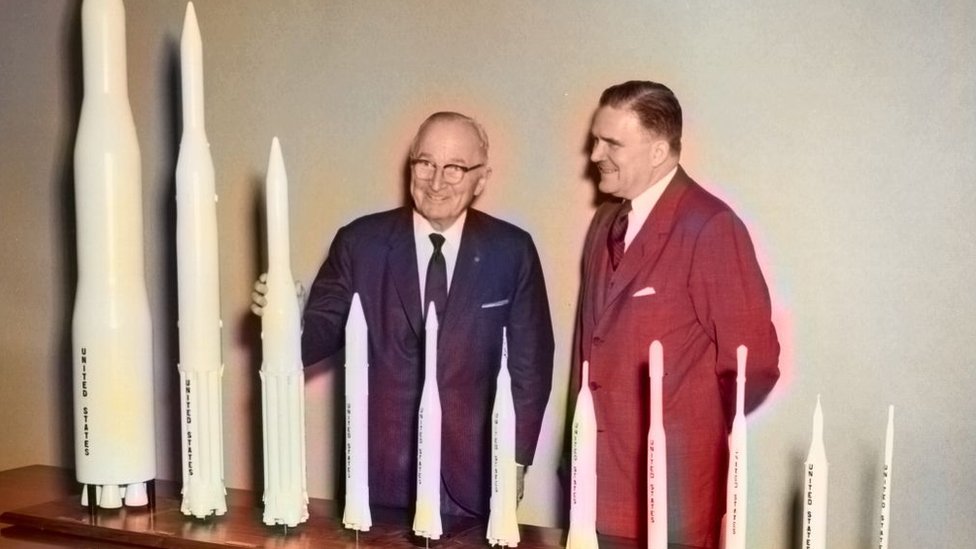NASA describes James Webb as the person who “did more for science than any other official” in the United States government.
Considered by many astronomers as one of the best managers of the space agency, under his supervision he undertook one of the most impressive projects in history: the landing of a man on the moon.
James Webb revolutionized the industry in such a way that NASA named the largest space telescope in history in his honor.
It’s a $10 billion spacecraft that took three decades to build and was originally known as the Next Generation Space Telescope, until 2002 named after the late former US official.
After its launch was delayed several times, the telescope finally began its mission on Saturday to search for the first stars that lit up the universe.
But who was James Webb?
Long career in public service
Born in 1906 in a small town, North Carolina, Webb earned a bachelor’s degree with a minor in arts.
He later became a second lieutenant in the United States Marine Corps, later serving as a pilot, while also pursuing a law degree.
North Carolina began his long career in American public service in 1932 as secretary to a member of the United States House of Representatives.
During World War II, he rejoined the Marine Corps, where he was responsible for the flight command and control unit.
At the end of the war, he returned to Washington and worked in the Office of Management and Budget, before serving as Under Secretary of State in the State Department from 1949 to 1952, under the Harry S. Truman government.
In the most important position at NASA
But the peak of his career did not come until almost 10 years later, when John F. Kennedy put him in the most important position in the US space agency by being appointed director of NASA on February 14, 1961, in the middle of space. The race between Washington and Moscow
He remained in the position for nearly the decade of the 1960s, at the head of the Apollo program, which fulfilled the human dream of a trip to the moon.
On its website, NASA explains: “Many believe that James E. Webb … has done more than any other government official possibly for science, and that it makes sense that the next generation space telescope bears his name.”
One of Kennedy’s promises was to get a man to the Moon before the end of the 1960s, but Webb thought the space program was more important than political action, according to the organization.
Webb also believes that NASA should strike a balance between manned spaceflight and science, as this would help boost college education and the US aviation industry.
His work left a decade of research in space science unparalleled even today.
“proper” salutation
NASA’s website claims that while Webb was in charge, the agency invested in developing a robotic spacecraft, which explored the lunar environment before astronauts arrived, and sent science probes to planets like Mars and Venus.
When Webb retired in July 1969, NASA launched more than 75 space science missions to study stars, such as the Sun and Earth’s atmosphere.
When announcing the new name for the next-generation space telescope, former NASA Administrator Sean O’Keefe said in 2002 that it was “appropriate” to pay tribute to James Webb’s work.
“He took our nation on its first expedition, and turned our imaginations into reality. Indeed, it laid the foundation for NASA to lead one of the most successful periods of astronomical discovery,” he said.
“As a result, we are rewriting textbooks today with the help of the Hubble Space Telescope, the Chandra X-ray Observatory and the James Webb Telescope.”
differences
Despite his achievements, some sectors consider him a controversial figure.
Many critics have argued for years that Webb was complicit in discrimination against LGBTQ employees in the 1940s, 1950s, and 1960s, as the US State Department undersecretary and NASA administrator.
In March 2021, in a column published by the American scientific journal Scientific American, a group of astronomers requested that the name of the space telescope be changed.
They claimed it “today honors the man who accepted the government’s anti-gay policies in the 1950s and 1960s”.
Referring to James Webb’s “positive role” at NASA, the signers noted that James Webb’s legacy is the “antithesis of sleep and freedom” that inspires exploration of time and space.
“It is unfortunate, then, that NASA’s current plan is to launch this incredible tool into space that bears the name of a man who is complex at best, and at worst reflects complicity in anti-gay discrimination in the federal government,” the group added. Astronomy scientists.
After an investigation, the space agency said it found no evidence to justify the name change.
You can now receive notifications from BBC Mundo. Download and activate our app so you don’t miss our best content.
BBC-NEWS-SRC: https://www.bbc.com/mundo/vert-cul-59781829, import date: 2021-12-25 18:00:09

“Beeraholic. Friend of animals everywhere. Evil web scholar. Zombie maven.”

:quality(85)/cloudfront-us-east-1.images.arcpublishing.com/infobae/PAGKJH7CJBDBHOF4XHKELQPZV4.jpg)





More Stories
Understandably, foreigners are interested in how we sleep in Spain
The municipal school health program begins this Thursday
Physicists have been trying to reconcile relativity and quantum mechanics for a century. And they have good reason